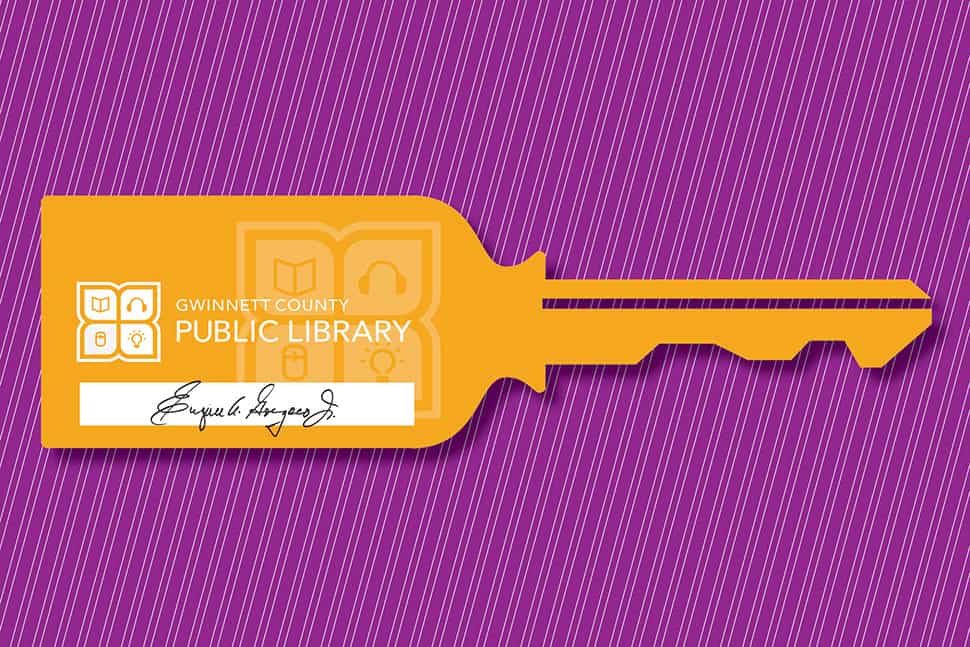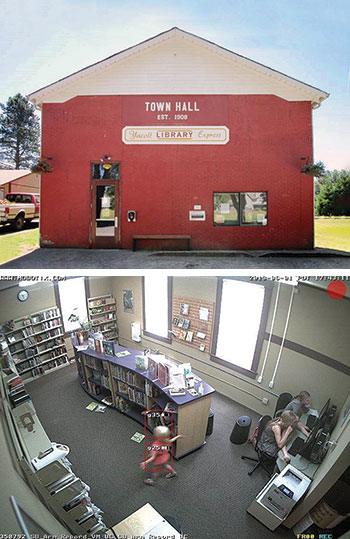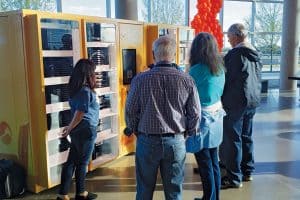
When Jacob Grussing, director of Scott County Library (SCL) in Shakopee, Minnesota, spoke to the local paper about SCL’s investigation into self-serve library services, he wasn’t exactly prepared for the patron fallout. Comments poured in supporting SCL’s staffers after the resulting article ran online with the headline “Libraries without Librarians?”
But he says any move to automate would be about expanding services, not cutting staff.
“I told that journalist, the conversation would regard whether we repurpose one of our staff, who is doing transactional work, to do more transformational work enhancing library resources and programs in senior living facilities or nursing homes or low-income housing community rooms,” Grussing explains. “It’s not a reduction but looking at how we currently staff our physical brick-and-mortar spaces.”
Automated and self-service libraries—which have been popular in Europe for years—are gaining a foothold in the US. Will these services eliminate librarian jobs, or are they a cost-effective way to stretch budgets and provide basic services while freeing staff for other work?
In 2016, Gwinnett County (Ga.) Public Library (GCPL) piloted automated self-service library technology at its Lawrenceville branch as a way to increase community access to the library’s resources. GCPL installed Open+, a system that grants patrons self-service use of a library outside normal operating hours through a card reader. The technology controls and monitors building entry, self-service kiosks, and public-access computers as well as lighting, alarms, public announcements, and patron safety. Open+, a bibliotheca product, is used by 800 libraries around the world, only a handful of them in the US.
Michael Casey, GCPL’s director of customer experience, says that the service has proven so popular that the library has added the technology to its Suwanee branch and is planning to add more locations. Initially, GCPL made self-service available for a $5 fee. The response to the new feature was so enthusiastic that administrators granted free access to all users 18 years and older, who check themselves in during early-morning hours when the library is open but staffers are not working in public areas.
Casey says about 2,000 visitors per month use self-service at the Lawrenceville branch, with another 1,000 at Suwanee. He adds that some of the most regular users include parents whose children have differing school drop-off times and who need a place where kids can play while parents read or catch up on work. Also, he says, “We have some very loyal newspaper readers every morning.”
Casey sees self-service libraries not so much as a cost-saving measure but as an added value. “We didn’t use it to replace any staff hours; we added on top of staff hours,” he explains. Adding 2–3 more staffers for the extra hours covered by the self-service tech was cost-prohibitive.

SCL’s Grussing is investigating self-serve options for that very reason. “It’s unrealistic to expect staffing to be expanded to provide that level of access across seven locations,” he says. “I think it’s our responsibility to find creative ways to create more value for residents’ tax dollars. If we can extend access and make it more convenient to use our library, it’s something to research and consider.”
Sam Wallin, project coordinator at Fort Vancouver Regional Libraries (FVRL) in Vancouver, Washington, used his colleagues as a sounding board before installing Telepen’s Sentry Isis system, the self-serve technology used at Yacolt (Wash.) Library Express, a mostly unstaffed branch in the former town hall. He conferred with librarians at nearby King County Library System, where patrons can scan themselves into the library after hours, about their process, tools, and services.
Based on its rural patrons’ needs, FVRL chose to provide Wi-Fi, computers, and checkout and check-in at the express branch. Because of the minimal staffing, it decided against incorporating self-serve tech for interlibrary loans, anything that requires a cash transaction, or daily newspapers. Patrons have to go to other branches for those services.
Security starts with trust
When it comes to patron safety in a self-serve library, Wallin says his philosophy is, “Start with trust and then backfill from there.” After he and his colleagues conferred with community members about what would and wouldn’t make them feel comfortable at a self-serve location, they decided against 24-hour access and installed video cameras and a phone system that could connect patrons with staff at other libraries. They also spotted and solved what he describes as “loopholes” in the system.
“People figured out that between midnight and 6 a.m., they couldn’t scan their card, but they could punch their card [number] in using the keypad,” which Wallin says led to patrons letting themselves into the library earlier than they were supposed to. “We used to joke about how people would break in to use our services,” he laughs. “Not to steal anything—they just wanted to check out their books.” His team solved the technical glitch but used it as a prompt to consider providing earlier hours.
Otherwise security hasn’t been an issue thus far.
“We haven’t had any problems that are worse or different than what you would find in a regular library,” Wallin says. For example, patrons are occasionally reluctant to leave at closing time, which is when the telephone intercom system comes in handy. Staffers from the nearest branch can check the security cameras at Yacolt—if they see someone lingering, they can announce: “The library’s going to close in about 10 minutes.” Wallin says that patrons sometimes think it’s just a recording, so staffers can say, “‘You, with the red shirt,’ or, ‘I see you, Jim!’” But otherwise, he says, “Nothing has really broken the model.”
“That’s the danger that a lot of people fear with automation, that it will replace something better with something worse, but I think it can be really useful to think about it as a step toward something.”
Sam Wallin, project coordinator at Fort Vancouver Regional Libraries in Vancouver, Washington
At GCPL, morning hours are unstaffed, but in the evening a contracted security agency is on call. The library system plans to break ground on two new buildings this summer, and Casey says his team is considering the option of a monitored security service along with Open+ that includes a significant array of security cameras. “That gives us pretty much total coverage of the branch, aside from inside the bathrooms,” he says. “We’re thinking of expanding the hours of our customer call center and having them watching the security camera at the same time.”
Typically, Casey says, the biggest complaint from patrons is when the copier goes down and they must wait for a staff member to assist. The library’s biggest incident to date, he says, was when one guest (who was trying to leave quickly after falling ill) knocked the library’s expensive new motion-sensor doors off the tracks. “He ended up taking the door down, although the glass didn’t break.”
Occasionally, Casey says, local branches have issues with homeless patrons trying to bring their belongings into the library during open hours. Grussing says his team is keeping that possibility in mind while it considers automation. “Like many public libraries, we try to be welcoming to all individuals, whether they’re experiencing homelessness or not. ‘How will the library prevent this when there’s extended access—how will you keep that from being a homeless shelter?’ I don’t have a solution for that, other than it’s something we’re going to have to talk about internally,” says Grussing. However, he adds, “the same rules and guidelines for the library that we have for staffed hours extend to self-service hours. If someone is coming into the space and not harming themselves or other people and following the code of conduct, it doesn’t matter what their housing status is. They should be able to use that space.”
Engage your stakeholders
When asked what lessons he would impart to libraries considering automated technology, Casey says they must know their demographics. “I think there are some locations where you might want a security guard at all times when it’s open, and others, like at some of ours, you may not need them at certain times of day.” Above all, he says, it’s important that libraries inform their customers when there is no staff present and about safety protocols during that time. “Just engage the customer and let them know that they might be the only person in the building,” he says. “You’re not trying to scare them; you’re just being transparent with the reality of the situation.”
Grussing adds that it’s important for library administrators to engage their staffers as early as possible—“especially your more procedurally minded staffers,” he said. “The folks who tend to sound the alarm bells quickly, they’ve been helpful to talk to. They can tick off 10, 15, 20 questions right away.” The sooner stakeholders are brought in, he says, the sooner administrators can address concerns.
Grussing says that of the 1,800 residents who responded to a survey on the possibility of automated library technology, “the overwhelming majority don’t want to see this impact current open hours, and they don’t want to see staffers negatively impacted.” He says that once most patrons understand that automation will complement, not replace, staff, it’s easier to work through the implementation issues. He adds that it was fun to read the feedback on the local “libraries without librarians” story, “to see how much people love their libraries and their librarians. That was the clearest thing that came out of the comments. Librarians matter, human connection matters.” (He jokes, “They don’t care for library directors that much.”)
The self-serve library is an improvement on Yacolt’s previous bookmobile, which, Wallin says, the public tended to see as a service for children. “If the library system is struggling where they’re like, ‘We can’t afford to keep a place open,’ and they decide to go with unstaffed automated access instead, I think that that would be seen as a loss,” Wallin says. “That’s the danger that a lot of people fear with automation, that it will replace something better with something worse, but I think it can be really useful to think about it as a step toward something.” He says that if the automated library continues to be a highly engaged service, then the city might take steps to create a full-service library.
GCPL went through many changes in 2016, the year it incorporated unstaffed hours, says Casey: “We got rid of our [stationary] help desk, got Open+, and changed our service model.” But he says that the new technology was one of the easiest changes. “I don’t want to jinx it, but it’s really worked out quite well,” he says. “I know from the numbers and from going out there every morning at Lawrenceville, the value we’re giving customers is great.”
Updated September 16: Corrected the second location of Open+ at Gwinnett County (Ga.) Public Library from Snellville to Suwanee.


